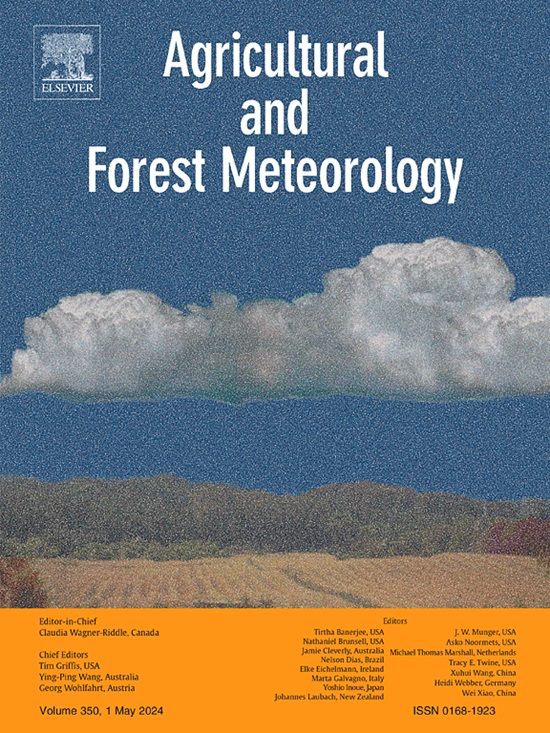Forcing experiment and model integration to validate an olive tree phenological model
IF 5.7
1区 农林科学
Q1 AGRONOMY
引用次数: 0
Abstract
Accurate assessment of chill and heat requirements is a fundamental challenge in phenological modeling of perennial fruit species, especially in the current climate change setting. Such models are typically calibrated and validated on the basis of long-term phenological and temperature records, without the integration of forcing experiments to highlight endodormancy release dates. Here we investigated olive tree flowering date modeling by combining a statistical approach and forcing experiments on the Picholine Marocaine cultivar with the aim of developing an olive phenological model for accurate assessment of chill and heat requirements. We initially assessed the endodormancy release date using a forcing experiment in 2021 and 2022 by comparing floral bud fresh weights under natural field conditions and after forcing conditions in a climate-controlled growing chamber. Subsequently, we used the PhenoFlex framework to calibrate and validate the model based on 31 years of flowering date and temperature data. We obtained an optimal model following nine calibrations with distinct season onset dates, and the latter were similar to the chilling onset date determined through a previous partial least squares regression approach. We also used endodormancy release dates to improve our model calibration by fitting the predicted flowering date to the observed value according to the recalibrated chill and heat requirement values. Finally, we validated the model based on six years of flowering date and temperature data. Our findings highlighted that the model calibrated solely via phenological records was less accurate than that calibrated based on a combination of phenological records and forcing experiment data. Our investigations broaden the scope for future applications of phenological olive tree modeling to accurately assess chill and heat requirements, which is currently a challenging issue facing olive growing in Mediterranean areas under climate warming.


强迫实验与模型整合验证橄榄树物候模型
准确评估冷热需求是多年生水果物候模型的一个基本挑战,特别是在当前气候变化的背景下。这些模型通常是在长期物候和温度记录的基础上进行校准和验证的,没有整合强迫实验来突出内休眠释放日期。本文采用统计学方法和强迫实验相结合的方法,对橄榄树开花日期模型进行了研究,目的是建立一个准确评估橄榄树冷热需求的物候模型。我们在2021年和2022年进行了一项强迫试验,通过比较在自然田间条件下和在气候控制的生长室内强迫条件下的花蕾鲜重,初步评估了内生休眠释放日期。随后,我们使用PhenoFlex框架对基于31年开花日期和温度数据的模型进行校准和验证。我们通过9次不同季节开始日期的校准获得了一个最优模型,后者与之前通过偏最小二乘回归方法确定的寒冷开始日期相似。我们还利用内休眠释放日期,根据重新校准的寒热需求值,将预测开花日期拟合到观测值,以改进模型校准。最后,基于6年花期和温度数据对模型进行了验证。我们的研究结果强调,仅通过物候记录校准的模型不如基于物候记录和强迫实验数据组合校准的模型准确。我们的研究拓宽了未来应用物候橄榄树模型的范围,以准确评估冷热需求,这是目前气候变暖下地中海地区橄榄种植面临的一个具有挑战性的问题。
本文章由计算机程序翻译,如有差异,请以英文原文为准。
求助全文
约1分钟内获得全文
求助全文
来源期刊
CiteScore
10.30
自引率
9.70%
发文量
415
审稿时长
69 days
期刊介绍:
Agricultural and Forest Meteorology is an international journal for the publication of original articles and reviews on the inter-relationship between meteorology, agriculture, forestry, and natural ecosystems. Emphasis is on basic and applied scientific research relevant to practical problems in the field of plant and soil sciences, ecology and biogeochemistry as affected by weather as well as climate variability and change. Theoretical models should be tested against experimental data. Articles must appeal to an international audience. Special issues devoted to single topics are also published.
Typical topics include canopy micrometeorology (e.g. canopy radiation transfer, turbulence near the ground, evapotranspiration, energy balance, fluxes of trace gases), micrometeorological instrumentation (e.g., sensors for trace gases, flux measurement instruments, radiation measurement techniques), aerobiology (e.g. the dispersion of pollen, spores, insects and pesticides), biometeorology (e.g. the effect of weather and climate on plant distribution, crop yield, water-use efficiency, and plant phenology), forest-fire/weather interactions, and feedbacks from vegetation to weather and the climate system.

 求助内容:
求助内容: 应助结果提醒方式:
应助结果提醒方式:


